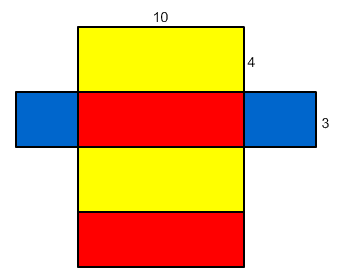Calculating Surface Area of a Prism
Once you have drawn the surfaces and labeled each accurately, the surface area can easily be found using what we already know.
|
Surface Area:
|
Example:
Let’s find the surface area of the rectangular prism we first looked at. Let’s say it has dimensions L = 10 in, W = 3 in, and H = 4 in.
 |
Rectangular box |
1. Draw and label the surfaces of the figure.
 |
Sides of the box laid out flat |
2. Find the area of each surface.
2 yellow sides: 10 by 4
A = 10(4) = 402 red sides: 10 by 3
A = 10(3) = 302 blue sides: 3 by 4
A = 3(4) = 12
3. Add the areas together.
2(yellow) + 2(red) + 2(blue) = 2(40) + 2(30) + 2(12) = 164
4. Label the answer with 'square units'.
The total surface area is 164 in².